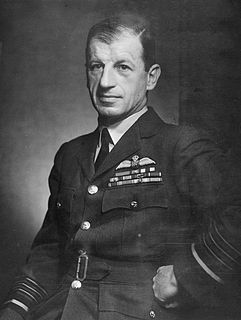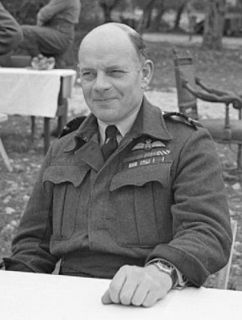
Marshal of the Royal Air Force Charles Frederick Algernon Portal, 1st Viscount Portal of Hungerford, was a senior Royal Air Force officer. He served as a bomber pilot in the First World War, and rose to become first a flight commander and then a squadron commander, flying light bombers on the Western Front. In the early stages of the Second World War he was commander-in-chief of Bomber Command. He was an advocate of strategic area bombing against German industrial areas, and viewed it as a war winning strategy. In October 1940 he was made Chief of the Air Staff, and remained in this post for the rest of the war. During his time as Chief he continuously supported the strategic bombing offensive against Germany, and advocated the formation of the Pathfinder Force, critical to improving the destructive force of Bomber Command. He fended off attempts by the Royal Navy to take command over RAF Coastal Command, and resisted attempts by the British Army to establish their own Army Air Arm. Portal retired from the RAF following the end of the war. He served as Controller of Production at the Ministry of Supply for six years. Portal was then made chairman of British Aluminium. He was unsuccessful in fending off a hostile takeover of British Aluminum by Sir Ivan Stedeford's Tube Investments, in what was known as the "Aluminium War". Afterward he served as chairman of the British Aircraft Corporation.

Marshal of the Royal Air Force Arthur William Tedder, 1st Baron Tedder, was a senior Royal Air Force commander. He was a pilot and squadron commander in the Royal Flying Corps in the First World War and he went on to serve as a senior officer in the Royal Air Force during the inter-war years when he served in Turkey, Great Britain and the Far East. During the Second World War, as Air Officer Commanding RAF Middle East Command, Tedder directed air operations in the Mediterranean and North Africa, including the evacuation of Crete and Operation Crusader in North Africa. His bombing tactics became known as the "Tedder Carpet". Later in the war Tedder took command of Mediterranean Air Command and in that role was closely involved in the planning of the Allied invasion of Sicily and then the Allied invasion of Italy. When Operation Overlord—the invasion of France—came to be planned, Tedder was appointed Deputy Supreme Commander at Supreme Headquarters Allied Expeditionary Force under General Eisenhower. After the war he served as Chief of the Air Staff, in which role he advocated increased recruiting in the face of many airmen leaving the service, doubled the size of RAF Fighter Command and implemented arrangements for the Berlin Airlift in 1948. After the war he held senior positions in business and academia.

Marshal of the Royal Air Force Sir Edward Leonard Ellington, was a senior officer in the Royal Air Force. He served in the First World War as a staff officer and then as Director-General of Military Aeronautics and subsequently as Controller-General of Equipment. In the inter-war years he held command positions in the Middle East, in India and then in Iraq. He served as Chief of the Air Staff in the mid-1930s and in that role he implemented a plan, known as 'Scheme F'. This scheme implemented an increase in the size of the Royal Air Force to 187 squadrons within three years to counter the threat from Hitler's Germany. He also broke up the command known as "Air Defence of Great Britain" to create RAF Fighter Command, RAF Bomber Command, RAF Coastal Command and RAF Training Command. He then served as Inspector-General of the RAF until his retirement in 1940.

Marshal of the Royal Air Force Sir William Forster Dickson, was a Royal Naval Air Service aviator during the First World War, a senior officer in the Royal Air Force during the inter-war years and a Royal Air Force commander during and after the Second World War. Dickson was Chief of the Air Staff in the mid-1950s, in which role his main preoccupation was the establishment of the V Force and the necessary supporting weapons, airfields and personnel. He also served as the first Chief of the Defence Staff in the late 1950s.

Gordon Lindsay Thomson was an English rower who competed in the 1908 Summer Olympics for Great Britain. During the First World War he served as a pilot in the Royal Naval Air Service and Royal Air Force.
Squadron Leader Leonard Henry Rochford was a British World War I flying ace credited with twenty-nine aerial victories. He returned to military service in the Royal Air Force during World War II.

Air Chief Marshal Sir Douglas Claude Strathern Evill, was an Australian-born Royal Naval Air Service pilot and squadron commander during the First World War. Serving in the Royal Air Force between the wars, he was a senior air commander during the Second World War.

Air Vice Marshal William Ernest Staton, was a British airman who began his career as a First World War flying ace credited with 26 victories. He was transferred to the Royal Air Force (RAF) on its creation in 1918 and remained in the RAF during the inter-war years. During the Second World War he served in England and pioneered the bombing technique of using pathfinders to mark targets. He then served in the Far East before becoming a prisoner of war to the Japanese. After the war he returned to Great Britain and the RAF where he reached air rank and twice captained the British Olympic Shooting Team.
Captain Charles Roger Lupton was a British World War I flying ace credited with five aerial victories.
Squadron Leader Herbert Gardner Travers was a World War I flying ace credited with five aerial victories. Post-war, he worked in civil aviation. He returned to service during World War II.
Air Vice Marshal Eric Bourne Coulter Betts, was an Irish air officer of the British Royal Air Force. He began his career in the Royal Naval Air Service during the First World War. He became a flying ace credited with six aerial victories, although acedom was incidental to his more important mission of long range photographic reconnaissance, for which he was decorated.
Captain Rowan Heywood Daly was a British flying ace credited with three aerial victories during World War I, and an additional four victories in Russia during 1919.
Captain Thomas Frederick Le Mesurier DSC & Two Bars was a British flying ace of the First World War credited with seven aerial victories. Le Mesurier was awarded the Distinguished Service Cross (DSC) and Two Bars for his conspicuous service in bombing operations.
Air Commodore Ernest William Norton was a British air officer of the Royal Air Force, who began his military career as a World War I flying ace credited with nine aerial victories. He remained in the RAF after World War I. He rose through the ranks in a mixture of domestic and foreign assignments until he was appointed Air Officer-in-Charge at RAF Headquarters in Singapore on 28 December 1937. By 7 September 1941, he was serving as an Air Commodore for Fighter Command in Britain. He retired from the RAF on 24 February 1944.
Group Captain Reginald Stuart Maxwell, was a British flying ace during World War I. He continued in RAF service until 1941, and served in the RNVR during World War II.

Air Vice-Marshal William Charles Coleman Gell, was an officer of the British Army and then of the Royal Air Force. He served as Air Officer Commanding-in-Chief at RAF Balloon Command from 1944 to 1945.
Air Vice Marshal Frederick George Darby Hards, was a Royal Air Force officer who served as Air Officer Commanding British Forces Aden from 1941 until his retirement in 1943.

Air Vice Marshal Harold Spencer Kerby, was Canadian-born air officer of the Royal Air Force. He served in the Royal Naval Air Service during the First World War, where he became a flying ace with nine confirmed aerial victories, later transferring to the Royal Air Force, rising to command of British Air Forces in East Africa during the Second World War.
Commander Norman Eyre Morley, was a British Naval Reserve officer who served in both World Wars, becoming the most decorated reserve officer in the Royal Navy, and the only person to have been awarded the Distinguished Service Cross four times.











